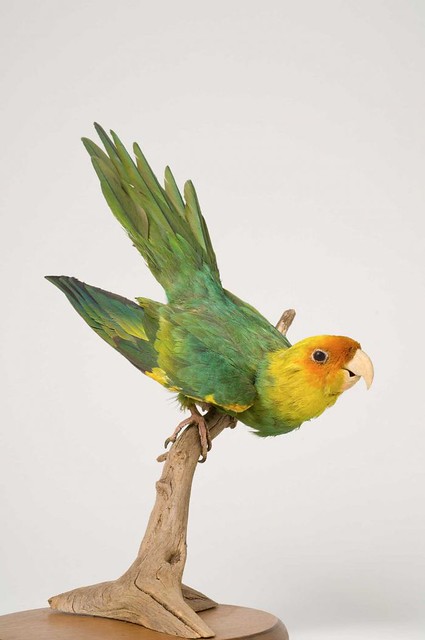 The Carolina parakeet, the only parrot once native to the eastern United States, has been extinct since the 1920s.From a nearly seven-foot ostrich skeleton to tiny hummingbirds, birds are one of strengths of the Bruce Museum's natural history collection. Most are housed securely in a compact, climate-controlled area of the museum's basement, awaiting their turn to become part of an exhibition, research project, educational program or loan to another institution. Some species have come from the tropics, Asia and Africa, but most are common birds of New England; however, a few are very rare.
The Carolina parakeet, the only parrot once native to the eastern United States, has been extinct since the 1920s.From a nearly seven-foot ostrich skeleton to tiny hummingbirds, birds are one of strengths of the Bruce Museum's natural history collection. Most are housed securely in a compact, climate-controlled area of the museum's basement, awaiting their turn to become part of an exhibition, research project, educational program or loan to another institution. Some species have come from the tropics, Asia and Africa, but most are common birds of New England; however, a few are very rare. The Carolina parakeet, the only parrot once native to the eastern United States, has been extinct since the 1920s.From a nearly seven-foot ostrich skeleton to tiny hummingbirds, birds are one of strengths of the Bruce Museum's natural history collection. Most are housed securely in a compact, climate-controlled area of the museum's basement, awaiting their turn to become part of an exhibition, research project, educational program or loan to another institution. Some species have come from the tropics, Asia and Africa, but most are common birds of New England; however, a few are very rare.
The Carolina parakeet, the only parrot once native to the eastern United States, has been extinct since the 1920s.From a nearly seven-foot ostrich skeleton to tiny hummingbirds, birds are one of strengths of the Bruce Museum's natural history collection. Most are housed securely in a compact, climate-controlled area of the museum's basement, awaiting their turn to become part of an exhibition, research project, educational program or loan to another institution. Some species have come from the tropics, Asia and Africa, but most are common birds of New England; however, a few are very rare.At first glance, this Carolina parakeet poised on a branch may look like a stuffed representation of a pet store bird. But the species Conuropsis carlinensis is the only parrot once native to the eastern United States, and it has been extinct since the 1920s.
This beautiful mounted bird invariably stirs reflection on vanishing wildlife around the world. The Bruce's rare specimen is one of only about 720 skins and 16 skeletons housed in museums around the world. The bird was donated to the museum in 1938 by Frank Ewing, whose grandfather had shot it.
Carolina parakeets once flourished in forests along rivers from southern New York and Wisconsin to the Gulf of Mexico. Some of the birds were taken for the pet trade. Much of their habitat was destroyed as woodland was replaced by farmland. Thousands were slaughtered by farmers because their large, noisy flocks fed on cultivated fruit, corn and other grain crops. Hunters also shot the birds for their bright feathers, which were used in the millinery trade. The mounted Carolina parakeet is a reminder of a time when passenger pigeons, egrets, shorebirds hawks and other birds were the victims of human thoughtlessness and greed. The decimation of their populations gave rise to federal and international laws in the early 20th century that continue to protect many birds today. Although it was too late for the Carolina parakeet and passenger pigeon, many bird populations have been restored. Environmental protection has become part of our public policy, and simply watching birds has become a passionate activity.
At Greenwich Point Park, new and experienced birders alike can expand their appreciation of avian life during free bird walks led by the Bruce Museum, Wild Wings Inc. and Audubon Greenwich. The walks begin at 9 a.m. near the concession stand on the first Sunday of each month -- no reservations are needed.
And what do they see?
Occasionally it may be another member of the parrot family that has taken up residence here. Monk parakeets originated in the temperate and subtropical areas of Argentina, but were imported as pets in the late 1960s and are now found in the United States from New England to the Midwest, southeast Texas, and Florida. The gregarious green-and-gray birds gather in flocks and build large, communal nests of sticks often on light poles in town parks.
The nests built at Greenwich Point have not produced young and have been abandoned, but adults still stop by in their search for food. Monk Parakeets are found in established colonies from Stamford to New Haven. When you see one, it just may remind you of its extinct cousin, the Carolina parakeet.
Cynthia S. Ehlinger is marketing and science curatorial associate at the Bruce Museum.